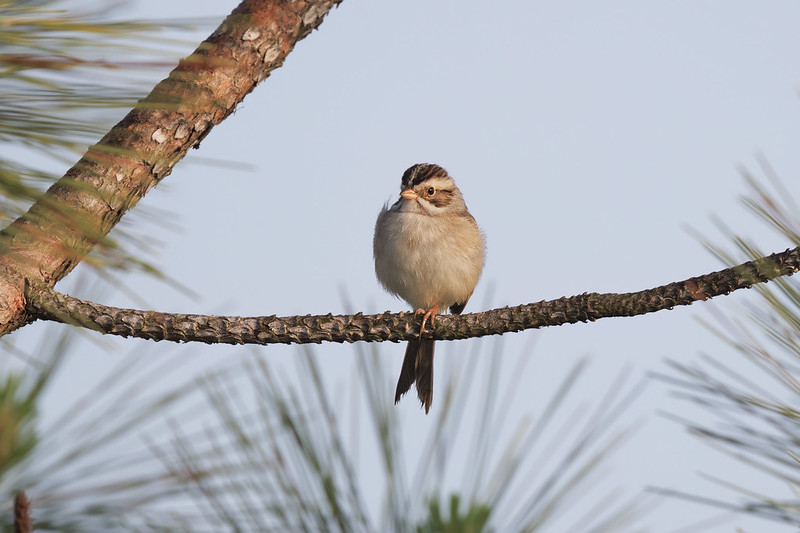I saw where Sandy Berger made a post on Facebook about seeing Clay-colored Sparrows at Sunnymede Park in Fort Smith, Arkansas. I decided to look for this bird the next time I went to this park on a photo walk because this would be a new bird for me. Sure enough, on my next visit, I spotted what I thought was the Clay-colored Sparrow in a pine tree next to the trail. After getting photos of this bird and arriving back home, I confirmed through a friend that this was indeed the Clay-colored Sparrow. I was lucky to see this bird and even more lucky to get a photo, but thanks to Sandy for posting about it on Facebook.

The Clay-colored Sparrow is a small, sparrow-sized bird with a slender body and a long, notched tail. It is a plain-looking bird with light brown upper-parts and pale underparts. The head is gray with a white supercilium (eyebrow) and a dark eyeline. The male has a blackish throat patch.
Clay-colored Sparrows are found in shrub-lands, field edges, and thickets across the northern prairies. They are also found in some parts of the eastern United States, but they are more common in the west.
Clay-colored Sparrows are insectivores, and they eat a variety of insects, including grasshoppers, beetles, and caterpillars. They also eat seeds and berries.
Clay-colored Sparrows are monogamous birds, and they typically mate for life. They build their nests on the ground, and the female lays 4-6 eggs. The eggs hatch after about 12 days, and the young birds fledge after about 14 days.
Clay-colored Sparrows are an important part of the prairie ecosystem. They help to control insect populations, and they are a food source for other animals. They are also a beautiful bird to watch, and they are a joy to photograph.
I am grateful to Sandy Berger for posting about the Clay-colored Sparrows on Facebook. I would not have known to look for them if it were not for her post. I am also grateful to the Clay-colored Sparrows for allowing me to get some photos of them. They are a beautiful bird, and I am glad that I was able to share them with you.
Gear Used:
- Camera: Canon EOS R7
- Lens: Canon RF 100-500 mm F4.5-7.1 L IS USM
Technical:
- Location: Sunnymede Park, Fort Smith (Arkansas)
- Date and Time Taken: May 9, 2023 (07:20 A. M.)
- Aperture: f7.1
- Shutter speed: 1/800
- ISO: 640 (Auto)
- Exposure Compensation: +1.0
- Focal Length: 500 mm
